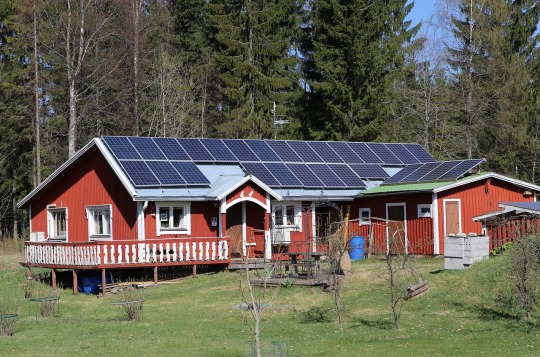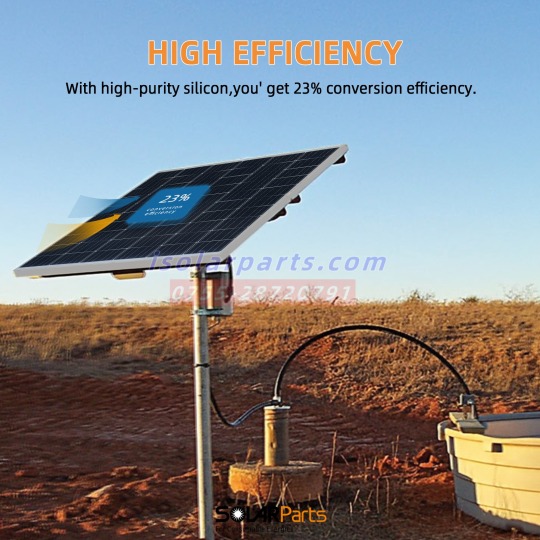#Monocrystalline solar panels
Text
A Deep Dive into Monocrystalline Solar Panels with Waaree.
As the world embarks on a sustainable future, solar energy emerges as a beacon of hope. Among its various technologies, monocrystalline solar panels stand out for their efficiency, durability, and sleek aesthetics. As one of best solar panel manufacturer, Waaree shines brightly with its commitment to Monocrystalline Solar Panels.
0 notes
Text

RenewSys Solar Panels is highly dependable and versatile modules made with the highest quality raw material coupled with
rigorous in-house testing, Suitable for Utility, Rooftop, and other general applications.
#RenewSys Solar Panels#solar panels#solar panel distributors#monocrystalline solar panels#solar inverters
0 notes
Text
NEEXGENT 450W Solar Panel Full Black Photovoltaic Highly Efficient Solar Panel For Solar System

Half Cut 450W High Efficiency Full Black Solar Panel Double Glass Module Low Price EU Stock Home Use Solar Power Panel
#neexgent#solar panels#monocrystalline pv solar panel#450w monocrystalline solar panel#half cut mono solar panel#mono solar panel#monocrystalline solar panels#solar energy#solar power#solar panel#solar system#solar pv#solar#full black solar panel
0 notes
Text
The Monocrystalline Solar Panel Market is expected to grow at a strong CAGR of 21.8% during the forecast period owing to the rising sale of solar panels and increasing investment in the renewable sector.
1 note
·
View note
Text
All about Benefits Solar Panel for a home in Dehli
Solar panels in Delhi have become increasingly common as the city strives to embrace renewable energy solutions and combat air pollution. These photovoltaic (PV) panels are installed on rooftops, and open areas, and even integrated into buildings, harnessing the abundant sunlight that Delhi receives throughout the year. As the capital city of India, Delhi faces significant energy demands, and solar panels offer a sustainable alternative to traditional fossil fuel-based electricity generation. With initiatives such as the Delhi Solar Policy and various incentives and subsidies provided by the government, the adoption of solar panels in Delhi has been on the rise. Homeowners, businesses, and government institutions are investing in solar energy to reduce their carbon footprint, lower electricity bills, and contribute to a cleaner and greener environment. As Delhi continues to expand its solar infrastructure, solar panels are expected to play a crucial role in meeting the city's energy needs while addressing environmental challenges.

What are the types of solar panels?
Solar panels come in various types, each with its own set of advantages and characteristics. The main types of solar panels include:
Monocrystalline Solar Panels: Made from high-purity silicon, monocrystalline solar panels have a single crystal structure, giving them a uniform black appearance. They are known for their high efficiency and space efficiency, making them ideal for installations with limited space.
Polycrystalline Solar Panels: Polycrystalline solar panels are made from multiple silicon crystals melted together, resulting in a less uniform appearance compared to monocrystalline panels. While they typically have lower efficiency than monocrystalline panels, polycrystalline panels are more cost-effective and offer good performance in various conditions.
Thin-Film Solar Panels: Thin-film solar panels are made by depositing thin layers of photovoltaic material onto a substrate, such as glass, plastic, or metal. They are lightweight, flexible, and less expensive to manufacture compared to crystalline silicon panels. However, thin-film panels generally have lower efficiency and degrade faster over time.
What are the components of solar panels?
Solar panels are composed of several key components, each playing a crucial role in harnessing sunlight and converting it into electricity. The main components of a solar panel include:
Photovoltaic (PV) Cells: PV cells are the core component of solar panels. These cells are made from semiconductor materials, typically silicon, which absorb sunlight and generate an electric current through the photovoltaic effect.
Encapsulation Material: PV cells are encapsulated in a durable and weather-resistant material, such as ethylene-vinyl acetate (EVA) or tempered glass, to protect them from environmental factors and ensure long-term performance.
Frame: Solar panels are typically housed in a rigid frame made from aluminum or steel, which provides structural support and protects the panel from physical damage.
Backsheet: The backsheet is a protective layer on the back of the solar panel, typically made from a polymer material, such as Tedlar or polyester. It provides insulation and moisture resistance, helping to protect the internal components of the panel.
Junction Box: The junction box is located on the back of the solar panel and houses electrical connections, diodes, and bypass diodes. It serves as the interface between the solar panel and external electrical components, such as wires and inverters.
Busbars: Busbars are thin metal strips that collect the electric current generated by the PV cells and transfer it to the junction box. They are typically made from copper or aluminum and are arranged in a grid-like pattern on the front surface of the solar panel.
Frontsheet: The frontsheet is a protective layer on the front of the solar panel, typically made from tempered glass. It is designed to transmit sunlight to the PV cells while providing durability and resistance to environmental factors, such as UV radiation and hail.
What are the benefits of solar panels in Delhi?
Solar panels offer several benefits to residents of Delhi, India, particularly in addressing energy needs, environmental concerns, and economic considerations:
Energy Independence: With abundant sunlight throughout the year, solar panels allow residents of Delhi to generate their own electricity, reducing dependence on the grid and fossil fuels. This independence provides resilience against power outages and price fluctuations in the electricity market.
Cost Savings: Solar panels enable residents to significantly lower their electricity bills by generating their own clean energy. Over time, the savings from reduced electricity bills can offset the initial investment in solar panel installation, leading to long-term financial benefits.
Environmental Sustainability: By harnessing solar energy, residents of Delhi can reduce their carbon footprint and contribute to environmental sustainability. Solar panels produce electricity without emitting greenhouse gases or other pollutants, helping to mitigate air pollution and combat climate change.
Government Incentives: The government of Delhi and the central government of India offer various incentives, subsidies, and rebates to promote the adoption of solar energy. These incentives can help offset the upfront costs of solar panel installation, making it more affordable for residents.
Energy Security: Solar panels enhance energy security by diversifying the energy mix and reducing reliance on imported fossil fuels. With locally generated solar energy, residents are less vulnerable to disruptions in fuel supply chains and geopolitical tensions.
Job Creation: The deployment of solar panels in Delhi creates job opportunities in various sectors, including manufacturing, installation, maintenance, and research. This job creation contributes to economic growth and empowers local communities.
Urban Development: Solar panels can be integrated into buildings and infrastructure, contributing to the aesthetic appeal and functionality of urban spaces. Solar-powered streetlights, water heaters, and other applications enhance the livability and sustainability of Delhi's urban environment.
What is the price of a solar panel?
The price of solar panels can vary widely depending on several factors, including the type and quality of the panels, the size of the system, installation costs, and location. here are some general price ranges for solar panels:
Residential Systems: For residential solar panel systems, prices typically range from 60000 to 95000 for a system size of 3 to 10 kilowatts (kW). This price range includes the cost of solar panels, inverters, mounting hardware, electrical components, and installation.
Conclusion - solar panels represent a transformative technology that holds immense potential to revolutionize the way we generate and consume electricity. As a clean, renewable energy source, solar panels offer numerous benefits, including reducing carbon emissions, mitigating climate change, and enhancing energy security. Despite some initial costs, the long-term economic advantages, such as savings on electricity bills and potential incentives, make solar panels an attractive investment for individuals, businesses, and governments alike.
0 notes
Text
The Cost of Powering a Home with Solar Energy: Understanding the Figures and Benefits
The rising cost of electricity bills has made more and more homeowners interested in exploring alternative sources of energy. One of the most popular options is solar power. In this blog post, we will discuss the cost of powering a home with solar power.
The cost of solar power for homes can vary depending on several factors such as the size of the solar panel system, the type of panels used,…

View On WordPress
#Average cost of solar panel system installation for a 3-bedroom house#Cost benefits of adding solar panel system to an existing home#Cost comparison between monocrystalline and polycrystalline solar panels#Cost of a 10-kilowatt solar panel system for a large home#Environmental and financial benefits of solar panel systems for low-income households#Factors affecting the cost of solar panel installation for a small home#Factors to consider when choosing a solar panel installation company for a commercial building#Installation cost of a solar panel system with battery storage for off-grid living#ROI analysis of a solar panel system for a 20-year period#solar energy#solar energy cost#solar panel cost#Solar panel system pricing in a specific state or region#solar power#solar power cost
0 notes
Text
Reliable Monocrystalline Solar Panel Manufacturers-Star Solar
Are you searching for a reliable manufacturer of monocrystalline solar panels? There is no need to look anywhere else! Star Solar is the perfect partner for those looking to get into the solar industry. Learn more about their products and services by contacting them today!
0 notes
Photo

Installing the best solar panels for your home is an excellent way to conserve energy and lower utility bills. Learn about the differences in the fabrication of solar panels and choose the most efficient option for your commercial or residential installation.
#solar panels#efficiency#photovoltaic#monocrystalline#polycrystalline#thin-film#residential#commercial#energy conservation#utility bills
0 notes
Text
How to Choose the Right Solar Panel for Your Home
How to Choose the Right Solar Panel for Your Home
<
p align=”justify”>Are you considering solar panels for your home but don’t know where to start? With so many different types, sizes, and prices of solar panels on the market, it can be difficult to choose the right one for your needs. In this blog post, we’ll help you understand the different types of solar panels, their sizes, and their prices so that you can make an informed decision when…

View On WordPress
#monocrystalline solar panel#polycrystalline solar panel#solar panel#thin film solar panel#types of solar panel
0 notes
Text

#RenewSys Solar Panels#polycrystalline solar panels#monocrystalline solar panels#solar panels#solar panel inverter
0 notes
Photo

Invisible Solar
Invisible Solar is a new PV technology that take on the appearance of any building material. Each Invisible Solar module is more than a photovoltaic panel, it also is an active architectural element with various functionality.
Disguising solar panels as ancient Roman tiles in Pompeii

"They look exactly like the terracotta tiles used by the Romans, but they produce the electricity that we need to light the frescoes," says Gabriel Zuchtriegel, Director of the Archaeological Park of Pompeii. This solution is part of a more comprehensive strategy to turn costs into savings opportunities and to embrace sustainable development.
Technically called "traditional PV tiles", the invisible solar panels used in Pompeii come from Camisano Vicentino, a little Italian town with slightly more than 10 000 inhabitants, halfway between Padua and Vicenza. They were created and patented by the family business Dyaqua.

How They Work

Operating of Invisible Solar modules is based on the low molecular density. Each module is composed of a non-toxic and recyclable polymeric compound we properly developed to encourage the photon absorption.
Inside the module there are incorporated standard monocrystalline silicon cells. The surface, that is opaque at the sight but translucent to sun rays, allows the light to enter and feed the cells.

Oh my goodness.
Solar voltaic’s designed for historic contexts that offers architectural and aesthetic integration?
AND they are already installed in Pompeii and not marketing vapourware?
AND they are made by a small Italian family business?
Be still my beating solarpunk heart 🥰 ☀️
via @stml in a forum.
#solarpunk#solar punk#solar power#voltaics#solar panels#terracotta#pompeii#renewables#solar energy#Aesthetic#Architecture
3K notes
·
View notes
Text
MO.CA: The Future of Sustainable Living in a Mobile Home

the Institute for Advanced Architecture of Catalonia (IAAC) has unveiled a groundbreaking project – MO.CA (MOBILE CATALYST). This modern mobile home, crafted from zero-kilometer natural materials and employing cutting-edge digital construction techniques, marks a new option for eco-friendly living.
Built entirely from sustainably harvested dowel-laminated wood sourced from IAAC’s Valldaura Labs in the Collserola Natural Park of Barcelona, MO.CA represents a fusion of traditional craftsmanship and modern innovation. This self-sufficient dwelling is designed to accommodate two individuals comfortably while boasting essential domestic amenities, all while minimizing its environmental footprint.

Powered entirely by solar energy, MO.CA can sustain 24 hours of continuous use without the need for recharging, making it truly self-sufficient. A set of three light-flexible monocrystalline solar panels connected to a MultiPlus inverter live on the roof, along with a backup battery, to keep unit up and running with power.
17 notes
·
View notes
Text
All benefits of Monocrystalline solar panels for homes in India
Monocrystalline solar panels, characterized by their single-crystal silicon composition, represent a pinnacle of efficiency and reliability in solar energy technology. These panels are meticulously crafted from a single continuous crystal structure, resulting in higher efficiency rates compared to other types of solar panels. This efficiency translates to greater energy production per square meter of panel area, making monocrystalline panels an ideal choice for residential, commercial, and industrial solar installations where space is limited. Beyond their efficiency, monocrystalline solar panels boast impressive longevity, often exceeding 25 years, and demonstrate resilience to harsh weather conditions. With their sleek appearance and high performance, monocrystalline solar panels continue to lead the way in the transition to clean, renewable energy sources, offering homeowners and businesses a reliable and sustainable solution for meeting their energy needs.

What are the types of mono solar panels?
Monocrystalline solar panels, renowned for their efficiency and durability, come in several types, primarily distinguished by the method used to manufacture the silicon wafers:
PERC Monocrystalline Solar Panels: PERC technology involves adding a passivation layer to the rear side of the solar cell, which reduces recombination losses and improves efficiency. PERC monocrystalline panels typically have higher efficiency and better performance in low-light conditions compared to standard monocrystalline panels.
Half-cut Monocrystalline Solar Panels: Monocrystalline half-cut solar panels are a cutting-edge innovation in solar panel technology that enhances efficiency and reliability. These panels feature solar cells that are physically cut in half, reducing resistance and increasing efficiency by minimizing energy loss. By dividing each cell into two smaller sections, half-cut panels mitigate the impact of shading and improve performance in low-light conditions. Additionally, the design of half-cut panels allows for greater resilience to micro-cracks and hot spots, enhancing overall durability and longevity.
Half-cut byfacial Monocrystalline Solar Panels: Monocrystalline half-cut bifacial solar panels represent a groundbreaking evolution in solar technology, combining the advantages of half-cut cells with the enhanced energy generation capabilities of bifacial panels. These innovative panels feature solar cells that are cut in half to reduce resistance and increase efficiency, while also allowing light to be absorbed from both the front and back sides of the panel.
What are the advantages of mono solar panels?
Monocrystalline solar panels offer several advantages that make them a popular choice for residential, commercial, and industrial solar installations:
High Efficiency: Monocrystalline solar panels are known for their high-efficiency rates, typically ranging from 15% to 22%. This means they can convert a larger percentage of sunlight into electricity compared to other types of solar panels, maximizing energy production per square meter of panel area.
Space Efficiency: Due to their high efficiency, monocrystalline panels require less space to generate the same amount of power as other types of solar panels. This is particularly advantageous for residential installations with limited roof space or where maximizing energy production is a priority.
Longevity and Durability: Monocrystalline solar panels have a long lifespan, often exceeding 25 years, and are known for their durability and resistance to harsh weather conditions. This makes them a reliable investment for the long term, especially in regions with extreme weather or temperature fluctuations.
Better Performance in Low-Light Conditions: Monocrystalline panels perform well in low-light conditions, such as cloudy days or early morning and late afternoon hours. Their efficiency in capturing sunlight makes them suitable for installations in areas with variable weather patterns or limited sunlight.
Aesthetic Appeal: Monocrystalline panels typically have a uniform black color and sleek appearance, making them aesthetically pleasing and suitable for residential installations. They blend well with most roofing materials and architectural styles, enhancing the overall look of the property.
Government Incentives: Many governments offer incentives, tax credits, and subsidies for homeowners and businesses that invest in solar energy systems, including monocrystalline panels. These incentives can help offset the upfront installation cost and make solar energy more accessible and affordable.
Environmental Benefits: By harnessing solar energy with monocrystalline panels, homeowners and businesses can reduce their reliance on fossil fuels, lower their carbon footprint, and contribute to environmental sustainability. This aligns with global efforts to combat climate change and transition to cleaner, renewable energy sources.
What is the price of a mono solar panel?
The price of monocrystalline solar panels can vary depending on several factors, including the manufacturer, efficiency rating, size, quantity purchased, and location. As of my last update, the average price range for monocrystalline solar panels in India is approximately ₹18 to ₹25 per watt for residential installations.
For larger commercial or utility-scale projects, prices may be lower due to economies of scale and bulk purchasing. Conversely, premium monocrystalline panels with higher efficiency ratings or advanced features may command a higher price.
Conclusion - monocrystalline solar panels stand as a beacon of efficiency, reliability, and sustainability in the realm of solar energy technology. With their high-efficiency rates, long lifespan, and durability, monocrystalline panels offer a compelling solution for homeowners, businesses, and governments seeking to harness the power of the sun for clean and renewable energy generation. Despite their initial cost, the long-term benefits of monocrystalline solar panels, including reduced electricity bills, energy independence, and environmental sustainability, make them a wise investment for the future. As advancements in technology continue to improve efficiency and lower costs, monocrystalline solar panels remain at the forefront of the transition to a cleaner and more sustainable energy landscape, paving the way for a brighter and greener future for generations to come.
0 notes
Text


Why Solar? Why SOLARPARTS?
You Control Your Electricity;
Lower Monthly Costs, and Added Value in Your Home;
Best Price and Choice, Guaranteed.
Solar Power Made Easy - Efficient Solar Solutions
#rigidsolarpanel#solarparts#solarenergy#energíasolar#Énergiesolaire#solarpanelsupplier#Solarpanelmanufacturer#solarpanelprice#solarpanelsforhome#RV#solar energy#solar power#energiasolar#energiasolare#太陽能
3 notes
·
View notes
Photo

The Perfect Being
A Seraph in the world-garden, surrounded by meat creatures. These beings did not evolve. Erecting the ziggurat in the background took a million years of work.
(DeviantArt)
This species did not arise from previous ancestors through evolution by natural selection: rather, it was created in its present form by a powerful, intelligent Creator for the purpose of glorifying Itself. The Creator acted within the constraints of the physics we know -- entropy, gravity, chemistry -- but, within those constraints, It had the power to shape Its creations however It willed. No requirement to develop them gradually through functional intermediates; no need to repurpose old structures for new functions; no necessity to make them respond to changes in the environment, or to antagonistic relations with other species.
The Creator chose a terrestrial planet somewhat larger than Earth, with weak but not negligible tectonic activity. The surface is about 60% water, and land is distributed in hundreds of islands ranging in size from Java to Australia, mostly placed along the Equator and the Polar Front, where wind and rain abund. Oceanic plates move just enough to create arcs of volcanic islands that link the mini-continents to each other. Proximity to water and a thick, moist atmosphere redistribute heat, ensuring balmy tropical temperatures worldwide. The rotation axis is perfectly perpendicular to the orbital plane, and kept stable by a large moon, so that there are no distinct seasons.
Land is almost entirely covered by a single biome: thick, springy tangles of a dark red sponge-like plant that absorbs sunlight at high efficiency, filling the atmosphere with oxygen and smoothing any unevenness in the ground; the roots secrete corrosive acids that make short work of minerals, but the upper surface is nothing but a soft moss-like carpet. The "animals" that move upon this surface suck fluids from the plant carpet through slender tube feet, converting them into dense proteins and fats that they store in their lumpy body; others burrow through the plant mass to ensure air circulation.
There are no predators or parasites; the population of these grazers is kept in check only by their tendency to spontaneously die of overcrowding, as a certain pheromone they secrete grows past a critical threshold. All animals reproduce asexually, and an extremely severe error-correcting mechanism aborts the process whenever a new mutation occurs. Dead bodies are quickly reabsorbed by the carpet.
This bare-bones biosphere exists for the benefits of the Creator's own chosen ones, which we will call Seraphim.
Their body is roughly starfish-like, a bit over 2 meters across, with a six-fold radial symmetry that allows them to move in any direction; it is supported by six muscular legs, each topped with an eye and an ear. The pads at the end of each limb contain sensitive tactile and chemical sensors that can measure the quality and depth of the plant carpet underfoot. From the center of the ventral side emerges a retractile head that carries a pair of smaller, more sensitive eyes and a range of chewing and manipulatory appendages. Largest of these are two lateral arms that end in branching tentacles, fit both to lift heavy loads and to handle delicate objects. The dorsal side of the body is covered by a dark flexible shell.
This shell is composed by thin overlapping layers of monocrystalline silicon that, when exposed to sunlight, accumulates electric potential through the photovoltaic effect, in practice acting as a solar panel. This electric potential is used to recharge energy-storing molecular bonds. Even though more efficient than photosynthesis, this is still not enough to feed a powerful, proactive intellect; thus, the photovoltaic shell has only an accessory role. The Seraphim draw most of their energy by grazing on the springy plant carpet or by eating the fat, slow-moving grazers, which can be easily grabbed and chewed at any time.
Metabolism is not far different from what we observe on Earth: reduced organic carbon reacts with atmospheric oxygen to release energy and carbon dioxide as waste. A ring of six hearts pumps blood through vessels from the central body into all appendages and back; vents in the ventral surface directly enrich blood with oxygen as it passes through each heart. Undigested food is reduced to an ash-like substance and compressed into pellets that are expelled from underneath the head. There are no gut bacteria: the Seraphim on their own can digest every compound in their food, and synthesize all chemicals they require from sugars, aminoacids, and minerals.
The brain is quite large (about 7 kg), divided in six redundant lobes, and protected under spongy layers beneath the shell. The reason for its size is the presence of channels in which flows what we will call the neural fluid. This is an extremely complex mixture of polypeptides, each "tagged" to interact with a particular neuron or set of neurons, chemically encoding the sum of information stored in the brain. It is, effectively, memory in a liquid form, as the activity of neurons constantly releases and destroys tagged polypeptides.
When two Seraphim wish to exchange information, the most complete way to do so is to exchange a part of neural fluid, which can be injected through a cannule located under the mouth. Each part flushes its own fluid from one or more lobes of its brain, and circulates for a while the partner's through it. In such a way, a Seraph can experience the very same impressions and thoughts of another one.
This form of communication is, of course, slow, energy-consuming, and only effective upon contact. (One can see from the expense of this arrangement why this species cannot subsist on light alone.) The Seraphim can sacrifice information density in favor of speed and range by communicating with radio waves. Controlled radio waves are generated thanks to a muscular organ above the brain, similar to the "batteries" of electric eels, which sends pulses of electricity across an insulated gap. The resulting waves are received by innervated conductive rods in the supporting legs, sheathed with crystalline zinc oxide to rectify the signal.
All appendages can be regenerated after loss, and voluntarily shed if heavily damaged. The Seraphim can only die before their time due to starvation, impact damage from a great fall or a collapse overhead, extensive bloodloss, or loss of enough appendages at the same time to overwhelm regeneration. Nevertheless, they are not immortal: even such beings inevitably accumulate small damages over time, and harmful mutations as their cells divide. Thus, at the age of a couple centuries, each Seraph simply dies as its brain shuts off, sending around a chemical that induces the plant carpet to quickly overgrow and dissolve the body.
Since the environment does not change significantly, and there are no parasites to race against, the additional genetic diversity produced by sexual reproduction is not necessary. The Seraphim all reproduce asexually, by parthenogenesis, conceiving and giving birth to clones of themselves whenever they sense the population density is under a certain threshold. During the process, the neural fluid is laboriously replicated, so that each Seraph is born with a copy of its parent's knowledge.
The Seraphim live in clonal groups of a few hundreds; species-wide genetic and cultural diversity is extremely low. They do not travel far from their birthplace, and there would be little reason to; although they are quick to explore uninhabited environments, in the rare occasions in which there are (for example, because a new volcanic archipelago emerged from the sea, or a mini-continent was suddenly depopulated by a catastrophe). Nevertheless they are intensely social: they engage in footpad-to-footpad "kissing" and mutual body grooming, bathing in freshwater ponds, and curling up limbs to roll down slopes. Playing is always cooperative rather than competitive. There is some long-distance exchange of carpet-plant tissue and meat creatures, since differences in weather and soil chemistry produce subtly different flavors from island to island.
The Seraphim were created to glorify their Creator, and glorify It they do. This is the purpose for which the vast majority of their considerable brainpower, social coordination, and brute strength exist. About a third of their time is devoted to composing electromagnetic hymns that are then broadcast in the form of radio waves. Multiple individual synchronize their hymns or build upon them, producing complex polyphonies that never repeat. The language in which these hymns are composed is also owed to the Creator, Which endowed it with millions of words and unspeakably byzantine syntax.
Another third of their time is occupied by other forms of devotion, that include carving and painting on stone, dancing, banquets, sacrifices of meat animals, elaborate mass-like ceremonies, and construction of temples and monuments. The last one is particularly significant, including all the largest common enterprises of the Seraphim: indeed, work on a single temple can require such an immense expense of time and materials that, by the time of completion, the oldest part may already be damaged by natural erosion. Indeed, construction time is so long that even such "permanent" structures erode away at the same rate at which they're built.
Seraph culture has existed approximately unchanged for about 280 million years as of present. As far as it can be determined, they are happy.
24 notes
·
View notes